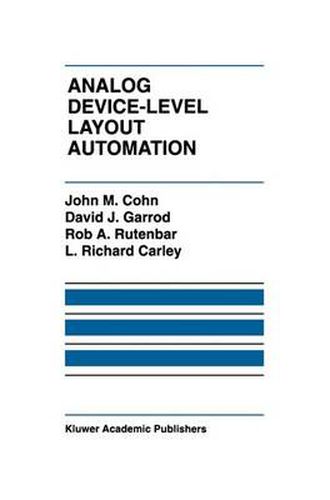Readings Newsletter
Become a Readings Member to make your shopping experience even easier.
Sign in or sign up for free!
You’re not far away from qualifying for FREE standard shipping within Australia
You’ve qualified for FREE standard shipping within Australia
The cart is loading…






This title is printed to order. This book may have been self-published. If so, we cannot guarantee the quality of the content. In the main most books will have gone through the editing process however some may not. We therefore suggest that you be aware of this before ordering this book. If in doubt check either the author or publisher’s details as we are unable to accept any returns unless they are faulty. Please contact us if you have any questions.
This book presents a detailed summary of research on automatic layout of device-level analog circuits that was undertaken in the late 1980s and early 1990s at Carnegie Mellon University. We focus on the work behind the creation of the tools called KOAN and ANAGRAM II, which form part of the core of the CMU ACACIA analog CAD system. KOAN is a device placer for custom analog cells; ANANGRAM II a detailed area router for these analog cells. We strive to present the motivations behind the architecture of these tools, including detailed discussion of the subtle technology and circuit concerns that must be addressed in any successful analog or mixed-signal layout tool. Our approach in organizing the chapters of the book has been to present our algo rithms as a series of responses to these very real and very difficult analog layout problems. Finally, we present numerous examples of results generated by our algorithms. This research was supported in part by the Semiconductor Research Corpora tion, by the National Science Foundation, by Harris Semiconductor, and by the International Business Machines Corporation Resident Study Program. Finally, just for the record: John Cohn was the designer of the KOAN placer; David Garrod was the designer of the ANAGRAM II router (and its predeces sor, ANAGRAM I). This book was architected by all four authors, edited by John Cohn and Rob Rutenbar, and produced in finished form by John Cohn.
$9.00 standard shipping within Australia
FREE standard shipping within Australia for orders over $100.00
Express & International shipping calculated at checkout
This title is printed to order. This book may have been self-published. If so, we cannot guarantee the quality of the content. In the main most books will have gone through the editing process however some may not. We therefore suggest that you be aware of this before ordering this book. If in doubt check either the author or publisher’s details as we are unable to accept any returns unless they are faulty. Please contact us if you have any questions.
This book presents a detailed summary of research on automatic layout of device-level analog circuits that was undertaken in the late 1980s and early 1990s at Carnegie Mellon University. We focus on the work behind the creation of the tools called KOAN and ANAGRAM II, which form part of the core of the CMU ACACIA analog CAD system. KOAN is a device placer for custom analog cells; ANANGRAM II a detailed area router for these analog cells. We strive to present the motivations behind the architecture of these tools, including detailed discussion of the subtle technology and circuit concerns that must be addressed in any successful analog or mixed-signal layout tool. Our approach in organizing the chapters of the book has been to present our algo rithms as a series of responses to these very real and very difficult analog layout problems. Finally, we present numerous examples of results generated by our algorithms. This research was supported in part by the Semiconductor Research Corpora tion, by the National Science Foundation, by Harris Semiconductor, and by the International Business Machines Corporation Resident Study Program. Finally, just for the record: John Cohn was the designer of the KOAN placer; David Garrod was the designer of the ANAGRAM II router (and its predeces sor, ANAGRAM I). This book was architected by all four authors, edited by John Cohn and Rob Rutenbar, and produced in finished form by John Cohn.